Building a More Predictive Protein Force Field: A Systematic and Reproducible Route to AMBER-FB15
- PMID: 28306259
- PMCID: PMC9724927
- DOI: 10.1021/acs.jpcb.7b02320
Building a More Predictive Protein Force Field: A Systematic and Reproducible Route to AMBER-FB15
Abstract
The increasing availability of high-quality experimental data and first-principles calculations creates opportunities for developing more accurate empirical force fields for simulation of proteins. We developed the AMBER-FB15 protein force field by building a high-quality quantum chemical data set consisting of comprehensive potential energy scans and employing the ForceBalance software package for parameter optimization. The optimized potential surface allows for more significant thermodynamic fluctuations away from local minima. In validation studies where simulation results are compared to experimental measurements, AMBER-FB15 in combination with the updated TIP3P-FB water model predicts equilibrium properties with equivalent accuracy, and temperature dependent properties with significantly improved accuracy, in comparison with published models. We also discuss the effect of changing the protein force field and water model on the simulation results.
Figures

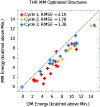
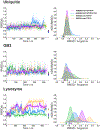
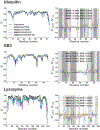
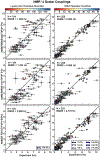
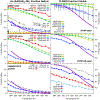

Similar articles
-
Development and Validation of AMBER-FB15-Compatible Force Field Parameters for Phosphorylated Amino Acids.J Phys Chem B. 2021 Nov 4;125(43):11927-11942. doi: 10.1021/acs.jpcb.1c07547. Epub 2021 Oct 20. J Phys Chem B. 2021. PMID: 34668708 Free PMC article.
-
Conformational Preferences of an Intrinsically Disordered Protein Domain: A Case Study for Modern Force Fields.J Phys Chem B. 2021 Jan 14;125(1):24-35. doi: 10.1021/acs.jpcb.0c08702. Epub 2020 Dec 31. J Phys Chem B. 2021. PMID: 33382616
-
Improved side-chain torsion potentials for the Amber ff99SB protein force field.Proteins. 2010 Jun;78(8):1950-8. doi: 10.1002/prot.22711. Proteins. 2010. PMID: 20408171 Free PMC article.
-
Biomolecular force fields: where have we been, where are we now, where do we need to go and how do we get there?J Comput Aided Mol Des. 2019 Feb;33(2):133-203. doi: 10.1007/s10822-018-0111-4. Epub 2018 Nov 30. J Comput Aided Mol Des. 2019. PMID: 30506158 Review.
-
Thermodynamic properties for applications in chemical industry via classical force fields.Top Curr Chem. 2012;307:201-49. doi: 10.1007/128_2011_164. Top Curr Chem. 2012. PMID: 21678137 Review.
Cited by
-
Quantitative Analysis of Protein Unfolded State Energetics: Experimental and Computational Studies Demonstrate That Non-Native Side-Chain Interactions Stabilize Local Native Backbone Structure.J Phys Chem B. 2021 Apr 8;125(13):3269-3277. doi: 10.1021/acs.jpcb.0c08922. Epub 2021 Mar 29. J Phys Chem B. 2021. PMID: 33779182 Free PMC article.
-
Extracellular loops of BtuB facilitate transport of vitamin B12 through the outer membrane of E. coli.PLoS Comput Biol. 2020 Jul 1;16(7):e1008024. doi: 10.1371/journal.pcbi.1008024. eCollection 2020 Jul. PLoS Comput Biol. 2020. PMID: 32609716 Free PMC article.
-
Toward Learned Chemical Perception of Force Field Typing Rules.J Chem Theory Comput. 2019 Jan 8;15(1):402-423. doi: 10.1021/acs.jctc.8b00821. Epub 2018 Dec 24. J Chem Theory Comput. 2019. PMID: 30512951 Free PMC article.
-
The automated optimisation of a coarse-grained force field using free energy data.Phys Chem Chem Phys. 2021 Nov 10;23(43):24842-24851. doi: 10.1039/d0cp05041e. Phys Chem Chem Phys. 2021. PMID: 34723311 Free PMC article.
-
Quantum Chemical Study of a Radical Relay Mechanism for the HydG-Catalyzed Synthesis of a Fe(II)(CO)2(CN)cysteine Precursor to the H-Cluster of [FeFe] Hydrogenase.Biochemistry. 2021 Oct 12;60(40):3016-3026. doi: 10.1021/acs.biochem.1c00379. Epub 2021 Sep 27. Biochemistry. 2021. PMID: 34569243 Free PMC article.
References
-
- Bash PA; Field MJ; Davenport RC; Petsko GA; Ringe D; Karplus M, Computer Simulation and Analysis of the Reaction Pathway of Triosephosphate Isomerase. Biochemistry-Us 1991, 30 (24), 5826–5832. - PubMed
-
- Gao J, Catalysis by Enzyme Conformational Change as Illustrated by Orotidine 5′-Monophosphate Decarboxylase. Current Opinion in Structural Biology 2003, 13 (2), 184–192. - PubMed
-
- Ridder L; Mulholland AJ; Rietjens IMCM; Vervoort J, A Quantum Mechanical/Molecular Mechanical Study of the Hydroxylation of Phenol and Halogenated Derivatives by Phenol Hydroxylase. J. Am. Chem. Soc. 2000, 122 (36), 8728–8738.
Publication types
MeSH terms
Substances
Grants and funding
LinkOut - more resources
Full Text Sources
Other Literature Sources

